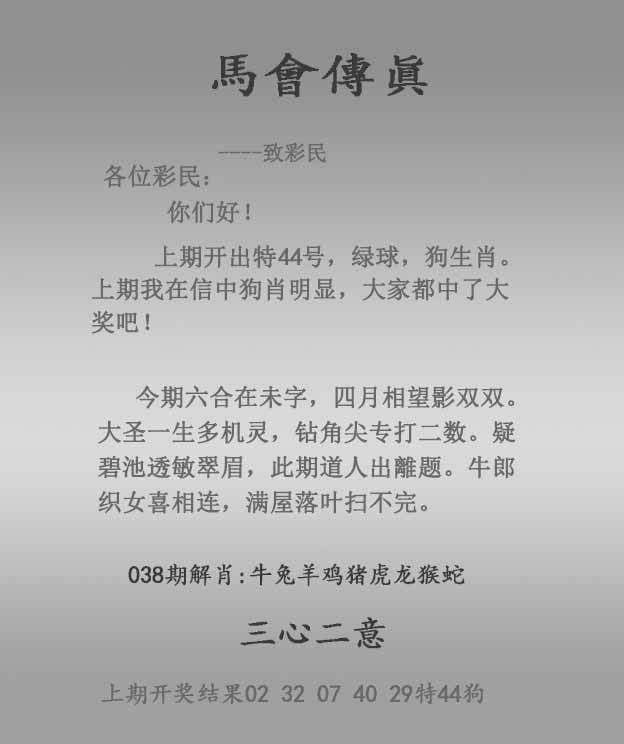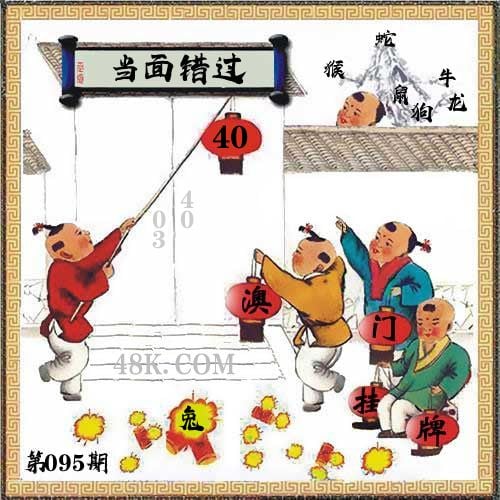
|
095期 | |
|---|---|---|
| 挂牌 | 40 | |
| 火烧 | 兔 | |
| 横批 | 当面错过 | |
| 门数 | 03,04 | |
| 六肖 | 蛇猴牛鼠龙狗 | |
- 095期:【贴身侍从】必中双波 已公开
- 095期:【过路友人】一码中特 已公开
- 095期:【熬出头儿】绝杀两肖 已公开
- 095期:【匆匆一见】稳杀5码 已公开
- 095期:【风尘满身】绝杀①尾 已公开
- 095期:【秋冬冗长】禁二合数 已公开
- 095期:【三分酒意】绝杀一头 已公开
- 095期:【最爱自己】必出24码 已公开
- 095期:【猫三狗四】绝杀一段 已公开
- 095期:【白衫学长】绝杀一肖 已公开
- 095期:【满目河山】双波中 已公开
- 095期:【寥若星辰】特码3行 已公开
- 095期:【凡间来客】七尾中特 已公开
- 095期:【川岛出逃】双波中特 已公开
- 095期:【一吻成瘾】实力五肖 已公开
- 095期:【初心依旧】绝杀四肖 已公开
- 095期:【真知灼见】7肖中特 已公开
- 095期:【四虎归山】特码单双 已公开
- 095期:【夜晚归客】八肖选 已公开
- 095期:【夏日奇遇】稳杀二尾 已公开
- 095期:【感慨人生】平特一肖 已公开
- 095期:【回忆往事】男女中特 已公开
- 095期:【疯狂一夜】单双中特 已公开
- 095期:【道士出山】绝杀二肖 已公开
- 095期:【相逢一笑】六肖中特 已公开
- 095期:【两只老虎】绝杀半波 已公开
- 095期:【无地自容】绝杀三肖 已公开
- 095期:【凉亭相遇】六肖中 已公开
- 095期:【我本闲凉】稳杀12码 已公开
- 095期:【兴趣部落】必中波色 已公开
| 095期:澳门天天好彩AA级公开; 还等啥大胆砸 |
|---|
| 095期:精选九肖:龙蛇兔虎羊鼠牛狗猪 |
| 095期:精选六肖:龙蛇兔虎羊鼠 |
| 095期:精选四肖:龙蛇兔虎 |
| 095期:精选三肖:龙蛇兔 |
| 095期:精选二肖:龙蛇 |
| 095期:精选一肖:龙 |
| 095期:精选尾数:9.5.7.1.6 |
| 095期:家禽野兽:野兽 |
| 095期:平特一肖:双数 |
| 095期:精选十码:26.38.25.15.28.35.06.29.08.19 |
| 095期:精选五码:26.38.25.15.28 |
| 095期:精选三码:26.38.25 |
| 六合活动进行中:站长担保 点击投注 |
| 095期:精选一码:重拳出击-26-信心十足 |
| 093期:澳门天天好彩AA级公开; 还等啥大胆砸 |
|---|
| 093期:精选九肖:狗龙猴牛羊鼠虎蛇马 |
| 093期:精选六肖:狗龙猴牛羊鼠 |
| 093期:精选四肖:狗龙猴牛 |
| 093期:精选三肖:狗龙猴 |
| 093期:精选尾数:0.9.3.6.4 |
| 093期:平特一肖:双数 |
| 六合活动进行中:站长担保 点击投注 |
| 092期:澳门天天好彩AA级公开; 还等啥大胆砸 |
|---|
| 092期:精选九肖:猴鼠马猪狗龙鸡虎兔 |
| 092期:家禽野兽:野兽 |
| 六合活动进行中:站长担保 点击投注 |
- 澳门平特心水
- 香港平特心水
095期平兔→兔马(2连)→兔马猴(3连)
- 澳门传真
- 香港传真
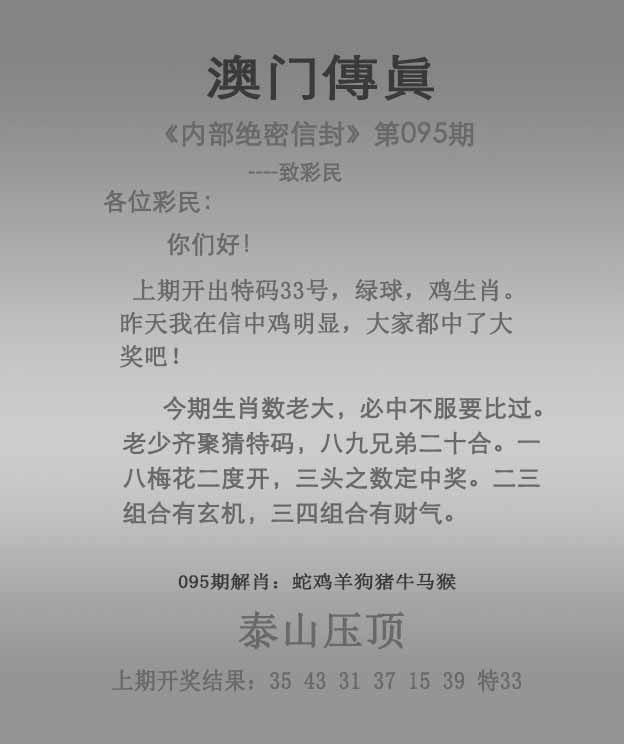
澳门传真095期
解:这段文字暗藏彩票玄机,以生肖隐喻特码数字:老大 指鼠(生肖首位), 八九兄弟 可能指龙蛇(排位8、9), 二十合 或为鸡(地支第十位)。梅花 象征虎(虎纹似梅), 三头 可解羊(未羊三横), 二三组合 为兔(排位4,2+3-1), 三四组合或指马(7位,3+4)。【生肖表达】鼠(老大必中)虎(梅花二度)兔(二三玄机)马(三四财气)羊(三头定奖)蛇(八九兄弟)鸡(二十相合)
七肖:鼠虎兔马羊蛇鸡
五肖:鼠虎兔马羊
三肖:鼠虎兔
主特:06.18.16.28.15.27.36.35.13.09
更多资料尽在新澳门开奖结果2025开奖记录
- 澳门五肖十码
- 香港五肖十码
095期推荐⑤肖:马鼠龙狗牛
095期推荐③肖:马鼠龙
095期推荐⑩码:36.48.06.18.14.26.08.20.17.29
095期推荐⑤码:36.48.06.18.14
更多资料尽在新澳门开奖结果2025开奖记录
- 澳门红字肖
- 香港红字肖
095期红字暗码【濠濮间想】【07 12 33 42】
解析:庄子在濠梁羡游鱼之乐,在濮水垂钓辞官,表现出一种超然物外之情。比喻暇逸超俗、悠然自得的会心或情趣。解羊猴鼠猪虎狗
解取特肖:羊猴鼠猪虎狗
解取五肖:羊猴鼠猪虎
解取四肖:羊猴鼠猪
092期红字暗码【士别三日】【04 15 38 41】
解析:指别人已有进步,当另眼相看。解马鼠兔羊鸡蛇
解取特肖:马鼠兔羊鸡蛇
解取五肖:马鼠兔羊鸡
解取四肖:马鼠兔羊
091期红字暗码【曲高和寡】【09 12 22 47】
解析:乐曲的格调越高,能跟着唱的人就越少。比喻思想言论或文艺作品不通俗,能理解的人很少。解鼠牛鸡虎马狗
解取特肖:鼠牛鸡虎马狗
解取五肖:鼠牛鸡虎马
解取四肖:鼠牛鸡虎
- 澳门平五不中
- 香港平五不中
095期【07.30.26.37.34】?
092期【19.48.41.06.30】准
090期【27.19.46.09.33】准
089期【40.11.12.02.32】准
087期【06.40.19.07.27】准
086期【03.04.41.21.22】准
085期【03.37.04.41.20】准
083期【08.20.24.31.42】准
081期【26.15.01.41.34】准
078期【34.36.01.09.45】准
077期【40.03.34.44.46】准
076期【09.46.04.11.45】准
074期【18.25.17.06.40】准
- 澳门传真20码
- 香港传真20码
095期澳门内幕传真20码开?00
特码玄机:302 179(马24)25+14= ?
冤家路窄要单挑,如日中天一定吉
提供20码:
15 39 19 20 01 42 49 08 31 47
04 22 14 05 17 11 07 12 38 48
- 澳门精准单双
- 香港精准单双
095期精准单双〖双数〗开:?00准
093期精准单双〖双数〗开:猴10准
091期精准单双〖双数〗开:虎40准
089期精准单双〖双数〗开:龙14准
088期精准单双〖单数〗开:兔15准
087期精准单双〖单数〗开:兔15准
085期精准单双〖单数〗开:羊35准
- 澳门玄机诗
- 香港玄机诗
095期【澳彩玄机诗】
雪月过十六,宰羊挂红灯:开?00
解:
094期【澳彩玄机诗】
楚馆处处通,起虎游八级:开?00
解:特码开鸡33
093期【澳彩玄机诗】
金城知天风,六通鲁门东:开猴10
解:特码开猴10
092期【澳彩玄机诗】
满面心欢喜,得意中奖来:开兔39
解:特码开兔39
091期【澳彩玄机诗】
清昼读书罢,焚香到日晡:开虎40
解:特码开虎40
- 澳门绝杀三只
- 香港绝杀三只
095期绝杀三只【蛇兔猴】开?00准
094期绝杀三只【羊马狗】开鸡33准
093期绝杀三只【鼠虎鸡】开猴10准
091期绝杀三只【牛鸡猴】开虎40准
089期绝杀三只【蛇羊马】开龙14准
088期绝杀三只【狗猴蛇】开兔15准
087期绝杀三只【狗猴蛇】开兔15准
086期绝杀三只【猪牛兔】开鼠30准
085期绝杀三只【鸡虎马】开羊35准
084期绝杀三只【鼠猴马】开狗20准
083期绝杀三只【猪龙羊】开虎28准
081期绝杀三只【狗虎猪】开龙38准
080期绝杀三只【猴兔鼠】开马24准
079期绝杀三只【猪鸡马】开猴10准
078期绝杀三只【鸡羊龙】开虎28准
077期绝杀三只【羊蛇虎】开猴22准
076期绝杀三只【鸡鼠虎】开兔39准
075期绝杀三只【兔猪狗】开鸡09准
074期绝杀三只【鸡鼠马】开羊35准
073期绝杀三只【牛龙蛇】开兔03准
072期绝杀三只【羊牛兔】开虎40准
071期绝杀三只【羊猴鼠】开蛇49准
070期绝杀三只【猴虎兔】开猪43准
069期绝杀三只【猴羊鸡】开牛29准
068期绝杀三只【虎蛇羊】开狗44准
067期绝杀三只【牛龙马】开狗44准
066期绝杀三只【虎蛇鸡】开马12准
065期绝杀三只【牛猪兔】开马48准
064期绝杀三只【羊虎兔】开猪31准
- 澳门藏宝图
- 香港藏宝图
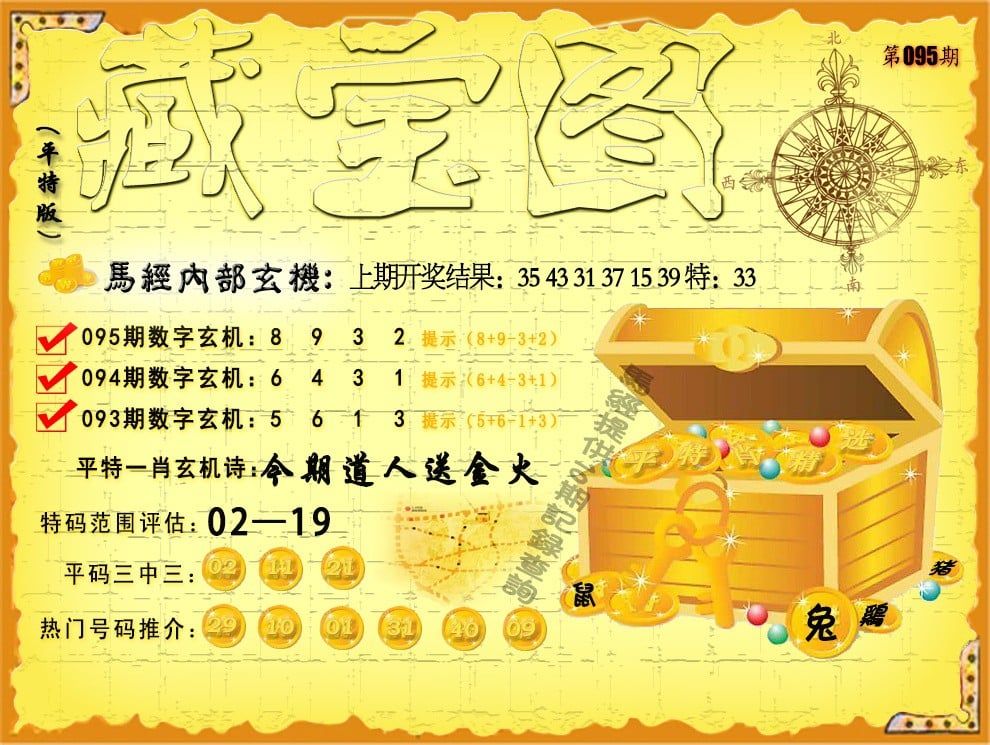
095期平特藏宝图玄机
【今期道人送金火】
解:今期道人送金火,平特猴鸡
特码范围评估:02-19
推荐平码:29.10.01.31.40.09
开奖结果:00-00-00-00-00-00T00
092期平特藏宝图玄机
【今期生肖三三加】
解:今期生肖三三加,平特虎羊
特码范围评估:01-20
推荐平码:20.18.02.30.40.08
开奖结果:23-24-36-03-04-32T39
089期平特藏宝图玄机
【今期权威放帖士】
解:今期权威放帖士,平特龙虎
特码范围评估:02-20
推荐平码:21.19.01.31.40.42
开奖结果:45-9-13-25-15-27T14
087期平特藏宝图玄机
【今期特码大林木】
解:今期特码大林木,平特虎猴
特码范围评估:02-20
推荐平码:21.18.01.31.39.40
开奖结果:30-16-14-28-29-03T15
086期平特藏宝图玄机
【今期生肖十一头】
解:今期生肖十一头,平特鼠鸡
特码范围评估:01-19
推荐平码:20.11.02.30.31.42
开奖结果:19-29-31-02-42-26T30
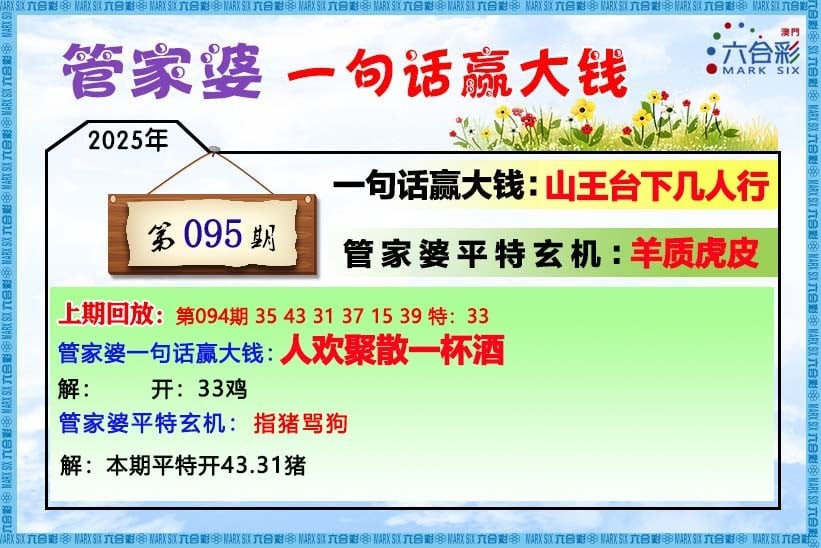
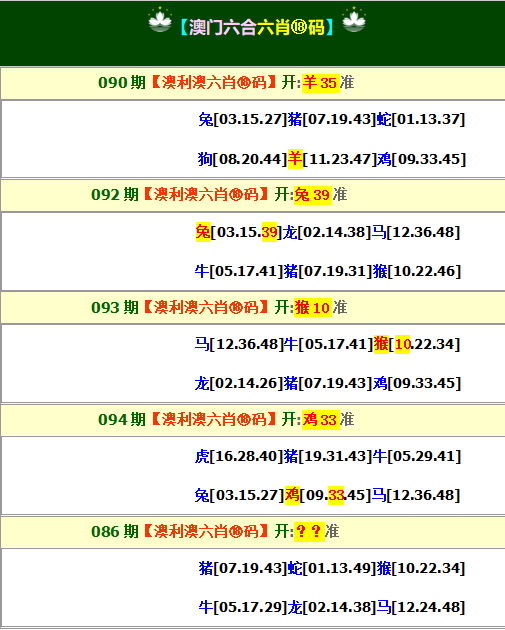

095期小小分析:这段描述以海狗与企鹅的对抗隐喻比较与竞争 ,暗藏玄机需结合图像解读。两者象征强势对峙、互不相让,可能暗指生肖间的较量或数字谜题(如排位、特征对比)。【生肖表达】鼠(子)——机灵善斗,暗藏心机;虎(寅)——霸气外露,压倒对手;龙(辰)——高傲不服,争强好胜;马(午)——奔放张扬,不甘示弱;猴(申)——狡黠攀比,智取为上;鸡(酉)——昂首挺胸,嘴硬争锋;猪(亥)——表面憨厚,暗较实力。玄机提示:可能隐含**子午冲 (鼠马对立)、辰戌冲 (龙狗斗)等生肖相克关系,或借动物特征(如企鹅黑白羽色)对应特码数字**(如12、38)
综合特肖:鼠虎龙马猴鸡猪
主攻四肖:鼠虎龙马
主攻特码:18.30.16.28.14.26.36.34.21.19
094期小小分析:这幅双鼠谋略图,暗藏7个关键生肖的联动玄机——鼠(子)×2:望远镜鼠(侦查先锋)笔记鼠(情报分析)▶ 体现子水双生,智谋叠加;猴(申):幕后军师角色(申金生水助鼠)▶ 望远镜象征猴的远见;龙(辰):侦查目标(辰为水库,暗喻远方大计)蛇(巳):情报传递者(巳火融金,蛇形暗线)鸡(酉):计划执行者(酉金为钟,精准行动)马(午):突围关键(午火冲子,时机突破)。阴谋阳谋解码:双鼠(情报)→ 猴(策划)→ 蛇(暗网)→ 鸡马(行动)→ 龙(终极目标)。排除牛虎兔羊狗猪等生肖,因缺乏间谍行动所需的**诡变(猴)与迅捷(马)**特质。图中望远镜暗示见龙在田,笔记簿暗藏申子辰三合水局——这或是生肖版的特工围猎大戏
综合特肖:鼠猴龙蛇鸡马
主攻四肖:鼠猴龙蛇
主攻特码:06.18.34.46.14.26.25.37.09.36
092期小小分析:这段谜语描述小猪被小狗追逐的奇特场景,暗藏生肖玄机。用7个生肖解读:猪——主角只穿衣服的小猪,象征财富(猪招财)或某种伪装。狗——锲而不舍追逐,代表忠诚或执着,也可能暗指狗猪相冲(戌亥相邻)。猴——穿衣奔跑似猴性机灵,善伪装(如孙悟空变化)。蛇——小猪跑到海边,蛇象征隐秘(水属阴),或暗示蛇猪相合(巳亥冲)。鼠——小狗为何狂追?鼠(子)与猪(亥)暗合水局,可能暗藏数字玄机。马——到处奔跑似马驰骋,但被追暗示马失前蹄。兔——小猪回头一望,兔机敏胆小,或暗藏卯亥未三合局。玄机:可能指向**猪狗冲(亥戌)**或隐藏水边相关生肖(鼠、蛇)
综合特肖:猪狗猴蛇鼠马兔
主攻四肖:猪狗猴蛇
主攻特码:19.31.08.20.34.46.37.18.36.15
091期小小分析:这段描述暗喻强弱对抗、生死博弈的玄机——山猫代表强势追击者(猎手),而野鸡象征弱势求存者(猎物),求饶无果暗示命运已定。图片玄机可能隐藏生肖相克、时机或方位的线索。【生肖喻】虎(山猫的凶悍)→ 2. 鸡(野鸡,本期焦点)→ 3. 蛇(暗中埋伏,如猫狩猎)→ 4. 兔(弱势挣扎,如鸡求饶)→ 5. 狗(追逐拦截,辅助猎杀)→ 6. 鼠(机敏逃脱失败)→ 7. 马(快速奔逃却难甩脱)。寓意:弱肉强食是自然法则,但若如龙(智慧)或猴(灵活)或能破局
综合特肖:虎鸡蛇兔狗虎马
主攻四肖:虎鸡蛇兔
主攻特码:16.28.09.21.13.25.27.08.28.36
088期小小分析:这段文字通过露营故事展现了才高八斗的智慧与守护之情,用生肖诠释如下:虎(男子守护如猛虎,威震荒野)兔(女友持棍自卫,柔中带刚似玉兔)狗(忠诚守夜,暗喻男子营外警戒)猴(才高八斗显急智,如猴灵活应变)蛇(棍如蛇形,暗藏防卫机锋)马(露营奔放自由,呼应野外冒险精神)猪(反衬安逸者,若无人守护则如猪般 vulnerable)龙鼠羊鸡牛未选——龙过尊不涉凡护,鼠羊怯弱,鸡牛无野营特质。核心以虎狗显守护,兔猴喻智勇,蛇马应情境,展现代版才子护佳人之趣
综合特肖:虎兔狗猴蛇马猪
主攻四肖:虎兔狗猴
主攻特码:16.28.27.39.08.20.34.37.24.19
087期小小分析:这段对话以幽默方式化解职场尴尬,用龙(画龙画虎开场,象征老板威严形象)牛(小勒打瞌睡像耕牛疲惫,暗喻职场辛劳)猴(老板急中生智的抓狂idea,体现猴的机灵)狗(小勒忠诚配合演出,如狗般顺从)鼠(万有引力联想到牛顿被苹果砸,鼠擅偷啃水果)蛇(下雨没砸到暗喻蛇般灵活躲过危机)兔(下次再砸展现兔子的侥幸心理)生肖智慧:职场如丛林,用龙威镇场、猴智解围、牛勤兔巧,方能蛇形走位化解危机。(注:生肖关联侧重情境隐喻而非字面直解)
综合特肖:龙牛猴狗鼠蛇兔
主攻四肖:龙牛猴狗
主攻特码:14.26.05.17.34.46.08.18.25.27
086期小小分析:这段文字以幽默口吻描述“怕痒”引发的尴尬场景——老中医因患者夸张反应被迫放弃治疗,强调“名誉”比赚钱更重要,充满生活喜剧色彩。生肖演绎(选取与情境契合的生肖特质):鼠:机灵滑头,反应夸张(对应“油嘴滑舌”)兔:敏感怕痒,一惊一乍(直接呼应“嗷一嗓子”)猴:戏精附体,演技浮夸(推动喜剧效果)鸡:嗓门洪亮,叫声突兀(模拟“推一下叫一声”)狗:忠诚守誉,中医大叔的坚持(“要名誉的人”)猪:憨态躺平,任人摆布(趴床任推拿的姿势)马:尥蹶子式反应(暗喻突然弹跳的怕痒者)缺(牛虎龙蛇羊):牛沉稳、虎凶猛、龙高傲、蛇隐忍、羊温顺,皆不符“滑稽逃诊”主题。核心生肖兔、猴、鸡,精准捕捉“痒觉敏感—夸张反应—名誉危机”的搞笑链条
综合特肖:鼠兔猴鸡狗猪马
主攻四肖:鼠兔猴鸡
主攻特码:06.18.15.27.34.46.09.08.19.36
084期小小分析:这段药店趣事通过谐音梗(泻闲/谢贤、泻停封/谢霆锋、泻停停/谢婷婷)制造笑料,展现小哥用机智化解顾客不适的暖心服务。【7生肖演绎】鼠(机灵)——小哥俏皮玩谐音梗牛(踏实)——认真推荐泻立停真药兔(敏捷)——迅速接话化解尴尬马(奔放)——脱口而出的明星谐音猴(诙谐)——用玩笑缓解顾客疼痛鸡(准时)——清晨疲惫进药店的顾客狗(忠诚)——药店小哥的职业精神
综合特肖:鼠牛兔马猴鸡狗
主攻四肖:鼠牛兔马
主攻特码:06.18.05.17.15.27.36.34.09.08
083期小小分析:这段文字描述了一群人在露营时迷路的幽默场景。“牛鬼蛇神”象征一群奇怪或有趣的人,“露营迷路”指在山中迷失方向,“走了很久走不出去”表现无奈。“拿出手机,报警”试图求救,但“喂,是110吗?”后,对方竟说“那就睡会儿吧”,随后挂断电话,充满荒诞感。用生肖表达:牛(牛鬼蛇神)、虎(山中困境)、兔(胆小)、蛇(牛鬼蛇神)、马(奔波)、猴(调皮)、狗(忠诚尝试求救)
综合特肖:牛虎兔蛇马猴狗
主攻四肖:牛虎兔蛇
主攻特码:17.29.16.28.15.27.37.36.46.08
082期小小分析:这段幽默小故事通过尴尬的误会,揭示了人际沟通中的微妙与荒诞:女生委婉提醒男友「鼻边有米粒」,实则暗示鼻屎需擦拭,但男友误以为是食物直接舔食,闹出笑话。用生肖特质可映射其中人性:鼠:机敏却过度迂回(女生用隐喻提醒)。牛:固执误解(男友坚持「米粒=可食用」)。虎:冲动直率(舔食动作毫无犹豫)。兔:温和避冲突(不敢直言「鼻屎」)。蛇:精明反被误(暗示策略失败)。猴:戏谑化解尴尬(事件自带喜剧效果)。狗:忠诚但笨拙(无条件信任对方话语)。深意:生肖特质暗合人性弱点——沟通中的「信息错位」常源自过度迂回(鼠/兔)与盲目直率(牛/虎),而幽默(猴)恰是化解尴尬的良药
综合特肖:鼠牛虎兔蛇猴狗
主攻四肖:鼠牛虎兔
主攻特码:30.42.29.41.16.28.27.25.34.08
081期小小分析:这个故事充满了戏剧性与幽默感:主人公为了接近心仪的看店女孩(水储风絮),每天买大量饮料,但最终却与垃圾回收站老板的女儿走到了一起,展现了缘分与现实的奇妙交织。用生肖表达:鼠:机灵聪明,善于制造机会。牛:憨厚执着,每天坚持买水。虎:勇敢主动,敢于追求心仪之人。兔:温柔可爱,象征看店女孩的形象。龙:胸怀大志,但缘分却出人意料。蛇:灵活应变,最终接受现实。猪:随缘知足,与垃圾站老板女儿结缘。这些生肖共同体现了故事中的幽默与人生无常的哲理
综合特肖:鼠牛虎兔龙蛇猪
主攻四肖:鼠牛虎兔
主攻特码:06.18.17.29.16.28.27.14.37.19
080期小小分析:这段文字描述了学校附近的刀削面馆和老板儿子的趣事,展现了孩子的天真与听话。用十二生肖中的7个来表达:鼠(机灵的孩子)、牛(勤恳的老板)、兔(乖巧听话)、蛇(面馆的隐秘角落)、马(面馆的热闹氛围)、羊(孩子的纯真)、狗(忠诚于妈妈的话)。这些生肖象征了面馆的日常场景,孩子的懂事与老板的辛勤,充满了生活气息
综合特肖:鼠牛兔蛇马羊狗
主攻四肖:鼠牛兔蛇
主攻特码:06.18.05.17.15.27.25.36.34.08
- 澳门四不像
- 澳门传真图
- 澳门跑马图
- 新挂牌彩图
- 另版跑狗图
- 老版跑狗图
- 澳门玄机图
- 玄机妙语图
- 六麒麟透码
- 平特一肖图
- 一字解特码
- 新特码诗句
- 四不像玄机
- 小黄人幽默
- 新生活幽默
- 30码中特图
- 澳门抓码王
- 澳门天线宝
- 澳门一样发
- 曾道人暗语
- 鱼跃龙门报
- 无敌猪哥报
- 特码快递报
- 一句真言图
- 新图库禁肖
- 三怪禁肖图
- 正版通天报
- 三八婆密报
- 博彩平特报
- 七肖中特报
- 神童透码报
- 内幕特肖B
- 内幕特肖A
- 内部传真报
- 澳门牛头报
- 千手观音图
- 梦儿数码报
- 六合家宝B
- 合家中宝A
- 六合简报图
- 六合英雄报
- 澳话中有意
- 彩霸王六肖
- 马会火烧图
- 狼女侠客图
- 凤姐30码图
- 劲爆龙虎榜
- 管家婆密传
- 澳门大陆仔
- 传真八点料
- 波肖尾门报
- 红姐内幕图
- 白小姐会员
- 白小姐密报
- 澳门大陆报
- 波肖一波中
- 庄家吃码图
- 发财波局报
- 36码中特图
- 澳门男人味
- 澳门蛇蛋图
- 白小姐救世
- 周公玄机报
- 值日生肖图
- 凤凰卜封图
- 腾算策略报
- 看图抓码图
- 神奇八卦图
- 新趣味幽默
- 澳门老人报
- 澳门女财神
- 澳门青龙报
- 财神玄机报
- 内幕传真图
- 每日闲情图
- 澳门女人味
- 澳门签牌图
- 澳六合头条
- 澳门码头诗
- 澳门两肖特
- 澳门猛虎报
- 金钱豹功夫
- 看图解特码
- 今日闲情1
- 开心果先锋
- 今日闲情2
- 济公有真言
- 四组三连肖
- 金多宝传真
- 皇道吉日图
- 澳幽默猜测
- 澳门红虎图
- 澳门七星图
- 功夫早茶图
- 鬼谷子爆肖
- 观音彩码报
- 澳门不夜城
- 挂牌平特报
- 新管家婆图
- 凤凰天机图
- 赌王心水图
- 佛祖禁肖图
- 财神报料图
- 二尾四码图
- 东成西就图
- 12码中特图
- 单双中特图
- 八仙指路图
- 八仙过海图
- 正版射牌图
- 澳门孩童报
- 通天报解码
- 澳门熊出没
- 铁板神算图
- 杀料专区
- 独家资料
- 独家九肖
- 高手九肖
- 澳门六肖
- 澳门三肖
- 云楚官人
- 富奇秦准
- 竹影梅花
- 西门庆料
- 皇帝猛料
- 旺角传真
- 福星金牌
- 官方独家
- 贵宾准料
- 旺角好料
- 发财精料
- 创富好料
- 水果高手
- 澳门中彩
- 澳门来料
- 王中王料
- 六合财神
- 六合皇料
- 葡京赌侠
- 大刀皇料
- 四柱预测
- 东方心经
- 特码玄机
- 小龙人料
- 水果奶奶
- 澳门高手
- 心水资料
- 宝宝高手
- 18点来料
- 澳门好彩
- 刘伯温料
- 官方供料
- 天下精英
- 金明世家
- 澳门官方
- 彩券公司
- 凤凰马经
- 各坛精料
- 特区天顺
- 博发世家
- 高手杀料
- 蓝月亮料
- 十虎权威
- 彩坛至尊
- 传真內幕
- 任我发料
- 澳门赌圣
- 镇坛之宝
- 精料赌圣
- 彩票心水
- 曾氏集团
- 白姐信息
- 曾女士料
- 满堂红网
- 彩票赢家
- 澳门原创
- 黃大仙料
- 原创猛料
- 各坛高手
- 高手猛料
- 外站精料
- 平肖平码
- 澳门彩票
- 马会绝杀
- 金多宝网
- 鬼谷子网
- 管家婆网
- 曾道原创
- 白姐最准
- 赛马会料
零顶商贸有限公司 YOUNGJUNG 成立于2012年,位于山东省青岛市,经营范围一般项目:服装辅料销售;服装服饰批发;鞋帽批发;箱包销售;工艺美术品及礼仪用品销售。。(ICP备案号)
友情链接:百度
网站的广告和外链,所有内容均转载自互联网,内容与本站无关!
本站内容谨供娱乐参考,不可用于不法活动,严禁转载和盗链等!并且防止相关欺骗性内容。
Copyright ©2012 - 2024 零顶商贸有限公司 YOUNGJUNG, All Rights Reserved










